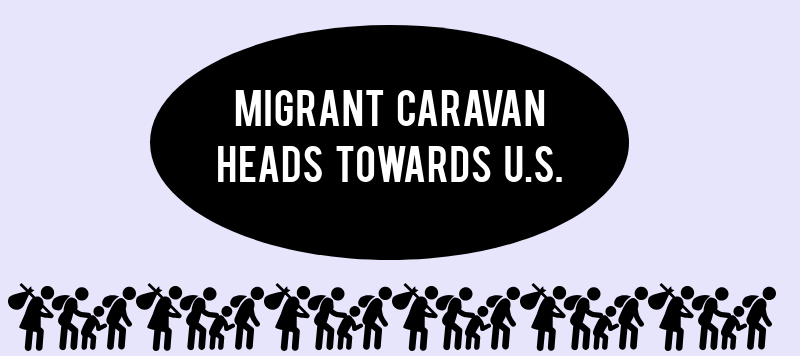Migrant Caravan Heads Towards the United States
November 2, 2018
On October 12, 2018, a group of migrants from Honduras began traveling to the United States in order to seek asylum from the various conditions they were living under. The caravan began in the town of San Pedro Sula, Honduras, which is one of the most violent cities in the world. The migrants started out as a group of 160, but their numbers have since grown.
VIDEO: Migrant Caravan moving north towards United States. @azcentral @USATODAY @usatodayvideo Follow @azdangonzalez @nickoza1 for updates of the #MigrantCaravans pic.twitter.com/wBuEyzvQ05
— azcentral (@azcentral) October 31, 2018
Although they have various reasons for seeking safety in Mexico and the United States, many of the migrants hope to escape the violence they faced in their home countries. Several members described the threats they received to their own lives, as well as the lives of their families. In San Pedro Sula alone, the murder rate is 173 people for every 100,000 residents. In addition, others journeying with the caravan want to escape poverty, as well as low wages.
After two days, the caravan’s number grew to around 1,000 people as the group passed through Honduras towards Guatemala. After another day, on October 15, the caravan reached 1,600 people as they arrived at the border of Guatemala. The Guatemalan government tried to close the border between their country and Honduras to stop the migrants, but they soon allowed the group to cross into Guatemala. The migrant caravan continued to the Mexico border, and along the way, accumulated up to 4,000 members.
However, at the Mexican-Guatemalan border, the migrant caravan was met with resistance. As the group made their way across the Suchiate River bridge between the two countries, chaotic events led the Mexican police to take action. They used tear gas, as well as smoke banisters, on the migrants.
Mexican authorities began to allow some members of the caravan to enter the country. In addition, they stated that those migrants who fit specific requirements, such as the possession of a visa, would eventually be admitted.
Emily Nash (‘20) said, “I think that the migrant caravan is a difficult situation because I know that they are coming from a rough area, and they are trying to find refuge either here or in Mexico. I also know that it is difficult to allow that large of a number into any country at any time. I also feel like the situation could be run more smoothly. It can be handled in a much better way. I do not think that they should be turned away, especially when they need our help, but I also understand that it is difficult to meet everyone’s needs.”
Various leaders of the United States continue to voice their opinions on the migrants’ journey. Specifically, President Donald Trump opposes the caravan’s entrance into the United States. Recently, he declared that 5,000 members of the military would be sent to the Mexican border to intercept the migrants.
Some Academy girls agree with Trump’s decision.
Clare Grammig (’21) said, “I support Trump’s decision because if they are coming into the United States, I think that some of our taxes will begin to go towards these other people who are not citizens of the United States. If they want to come into the country, they should do it legally because what makes them more entitled to come into our country than those who have been waiting for years?”
To those in the Caravan, turnaround, we are not letting people into the United States illegally. Go back to your Country and if you want, apply for citizenship like millions of others are doing!
— Donald J. Trump (@realDonaldTrump) October 25, 2018
In addition, United States Secretary of State Mike Pompeo made statements in support of Mexico and the country’s actions.
Pompeo said, “This [the caravan] is an organized effort to come through and violate the sovereignty of Mexico. We’re prepared to do all that we can to support the decisions that Mexico makes about how they’re going to address this very serious and important issue to their country.”
As of now, the caravan is still 1,000 miles away from reaching the United States.
Chanita Belcher (’19) said, “I don’t necessarily see anything wrong with people who are in danger in their home country that go migrate to another country to hopefully become a refugee. I feel like if America or Mexico can keep them [the migrants] for as long as possible, until either things calm down or they can get jobs working in either country, then that should be acceptable. Our President is all about taxes and the lack of jobs, so if our country gives them enough time to get those jobs and to pay those taxes, they should be given the opportunity to take refuge in our country.”

